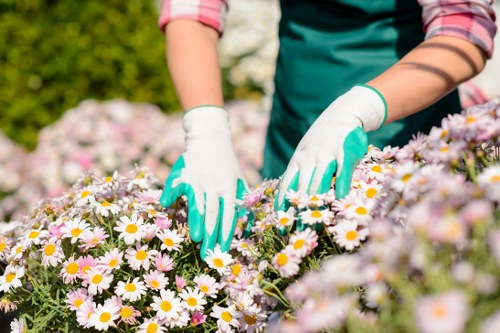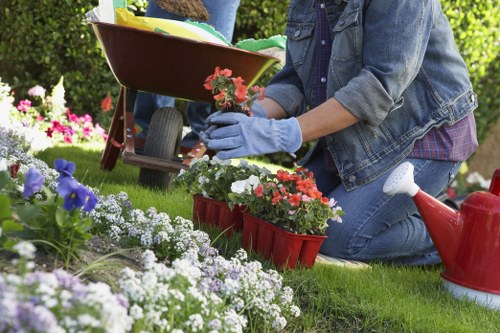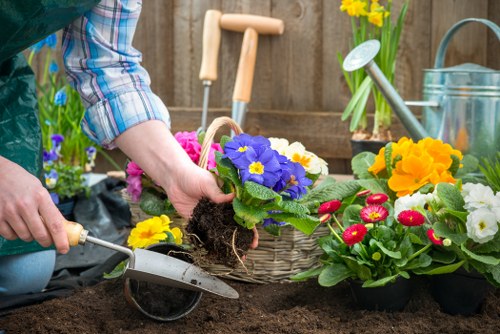Garden Clearance in Garden Fence Replacement

Garden clearance is a vital step in the process of garden fence replacement. Proper clearance ensures that the new fence is installed seamlessly, enhancing both the aesthetic and functional aspects of your outdoor space. Whether you're updating an old fence or installing one for the first time, a thorough garden clearance can make all the difference.
Before embarking on a fence replacement project, it's essential to assess the current state of your garden. This assessment helps identify any obstacles that might hinder the installation process. By clearing out debris, overgrown plants, and other unwanted elements, you create a clean slate for your new fence.
In addition to improving the installation process, garden clearance can also enhance the overall health and appearance of your garden. Removing dead plants and excess vegetation allows for better air circulation and sunlight penetration, promoting healthier plant growth.
Why Garden Clearance is Essential

When replacing a fence, garden clearance plays a crucial role in ensuring the new structure is properly supported and installed. Overgrown plants and debris can interfere with the fence posts, making it difficult to achieve a level and secure installation.
Moreover, a well-cleared garden can prevent future maintenance issues. By removing potential growth obstacles now, you reduce the chances of the new fence being compromised by invasive plants or root systems in the future.
Additionally, garden clearance contributes to the overall safety of your property. Clearing pathways and removing obstructions can prevent accidents and make your garden more accessible.
Planning Your Garden Clearance
Assessing Your Garden

Before you begin the clearance process, take the time to thoroughly assess your garden. Identify which areas need the most attention and determine the extent of the work required. This assessment will help you create a detailed plan, ensuring that no area is overlooked.
Consider creating a map of your garden, marking areas with overgrown plants, debris, or other obstacles. This visual aid can be invaluable in organizing your clearance efforts effectively.
During the assessment, also take note of any existing structures or features that may need protection during the clearance process. This includes delicate plants, decorative elements, or utility lines that could be affected.
Tools and Equipment Needed

Proper tools and equipment are essential for an efficient garden clearance. Depending on the scale of the project, you may require:
- Pruning shears and loppers for trimming overgrown plants
- Garden saws for cutting through thick branches
- Rakes and shovels for debris removal
- Wheelbarrows for transporting waste
- Protective gear such as gloves, goggles, and safety boots
Having the right tools on hand will not only make the clearance process smoother but also ensure your safety throughout the project.
Step-by-Step Garden Clearance Process
Removing Debris and Overgrowth

Begin the clearance process by removing all debris from your garden. This includes fallen branches, leaves, and any other organic matter that has accumulated. Clearing debris provides a clean workspace and prevents any hindrances during fence installation.
Next, address overgrown plants. Trim back any encroaching vegetation that could interfere with the new fence. This step is crucial in ensuring that your fence has ample space to be installed without obstruction.
For areas with significant overgrowth, consider using a weed trimmer or even a brush cutter to efficiently clear the space. Always follow safety guidelines when using such equipment to avoid accidents.
Pruning and Trimming
After removing debris, focus on pruning and trimming your plants. Proper pruning not only improves the appearance of your garden but also promotes healthier plant growth by allowing more sunlight and air to reach the plants.
Start by removing any dead or diseased branches, as these can negatively impact the overall health of your garden. Then, proceed to trim back any overgrown sections that could interfere with your fence replacement project.
Regular pruning can significantly reduce the amount of maintenance required for your new fence, ensuring it remains in good condition for years to come.
Soil Preparation
Soil preparation is the final step in the garden clearance process. Before installing your new fence, ensure that the soil is properly prepared to support the fence posts.
Remove any remaining plant material and loosen the soil to provide a stable base for the fence. If necessary, amend the soil with compost or other nutrients to improve its structure and fertility.
Proper soil preparation not only facilitates fence installation but also promotes a healthy garden environment, supporting the growth of new plants and vegetation around your fence.
Common Challenges in Garden Clearance
Dealing with Stubborn Weeds

One of the most common challenges in garden clearance is dealing with stubborn weeds. These invasive plants can quickly take over your garden, making the clearance process more time-consuming and labor-intensive.
To effectively manage weeds, consider using a combination of manual removal and herbicides. Regular maintenance and monitoring can prevent weeds from becoming a persistent problem.
Mulching is another effective strategy for controlling weed growth. By covering the soil with mulch, you can suppress weed seeds and reduce the need for frequent weeding.
Managing Tree Roots

Tree roots can pose a significant obstacle during garden clearance, especially when installing new fence posts. Deep or widespread roots can interfere with the placement and stability of fence foundations.
In cases where tree roots are problematic, it may be necessary to consult with a professional arborist to safely remove or manage the roots without causing harm to the tree or surrounding vegetation.
Proper planning and excavation techniques can help mitigate the impact of tree roots on your fence replacement project, ensuring a secure and lasting installation.
Eco-Friendly Garden Clearance Practices

Embracing eco-friendly garden clearance practices not only benefits the environment but also promotes a sustainable garden ecosystem. Consider the following strategies to make your clearance process more environmentally friendly:
- Recycle and compost organic debris instead of disposing of it in landfills.
- Use manual tools when possible to reduce carbon emissions associated with powered equipment.
- Implement integrated pest management (IPM) techniques to control unwanted plants without relying heavily on chemical herbicides.
- Preserve beneficial plants and wildlife habitats by selectively clearing areas, rather than blanket removal.
By adopting these practices, you contribute to the health and sustainability of your garden while still achieving effective clearance for your fence replacement.
Integrating Clearance with Fence Installation
Aligning Clearance with Fence Design

When planning your garden clearance, it's important to align your efforts with the design and functionality of your new fence. Consider how the cleared areas will interact with the fence structure, ensuring that the layout complements both the garden and the fence.
This alignment can enhance the visual appeal of your garden and provide a cohesive look that integrates the new fence seamlessly into your outdoor space.
Additionally, thoughtful planning can help you optimize the placement of plants and decorative elements around the fence, creating a harmonious and inviting garden environment.
Ensuring Long-Term Maintenance
Effective garden clearance sets the foundation for long-term maintenance of your new fence. By removing potential growth obstacles and creating clear pathways, you simplify future upkeep tasks and extend the lifespan of your fence.
Implementing a regular maintenance schedule can help sustain the cleanliness and health of your garden, ensuring that both the vegetation and the fence remain in optimal condition.
Moreover, proactive maintenance can prevent minor issues from escalating into significant problems, saving you time and resources in the long run.
Hiring Professionals vs. DIY

Deciding whether to hire professionals or undertake garden clearance as a DIY project depends on various factors, including the size of your garden, the complexity of the clearance required, and your personal skill level.
Professional garden clearance services offer expertise and efficiency, ensuring that the job is done thoroughly and safely. They come equipped with the necessary tools and experience to handle even the most challenging clearance tasks.
On the other hand, a DIY approach can be cost-effective and rewarding for those with the time and skills to manage the project. However, it's important to consider the potential risks and ensure you have the appropriate knowledge and equipment to carry out the clearance effectively.
Costs and Budgeting for Garden Clearance and Fence Replacement

Budgeting for garden clearance and fence replacement involves considering several cost factors. These include the size of your garden, the extent of the clearance required, the materials for the new fence, and whether you opt for professional services or a DIY approach.
To create an accurate budget, start by obtaining quotes from reputable garden clearance and fence installation companies. Compare these quotes to determine the most cost-effective option that meets your needs.
Additionally, allocate funds for unexpected expenses that may arise during the project, such as the removal of large tree roots or the need for additional materials.
Tips for a Successful Garden Clearance Project

Achieving a successful garden clearance project requires careful planning and execution. Here are some valuable tips to ensure your project runs smoothly:
- Create a detailed plan: Outline the steps and timeline for your clearance and fence replacement project.
- Gather the necessary tools: Ensure you have all the required equipment before starting.
- Prioritize safety: Use protective gear and follow safety guidelines to prevent accidents.
- Work systematically: Tackle one section of the garden at a time to maintain organization and efficiency.
- Dispose of waste responsibly: Recycle or compost cleared materials to minimize environmental impact.
- Seek professional advice: Consult with experts if you encounter challenges beyond your expertise.
Implementing these tips can help you navigate the garden clearance and fence replacement process with confidence and ease.
Conclusion
Garden clearance is an indispensable component of any garden fence replacement project. By thoroughly clearing your garden, you pave the way for a successful fence installation that enhances the beauty and functionality of your outdoor space.
Whether you choose to hire professionals or tackle the project yourself, proper planning and execution are key to ensuring a smooth and efficient process. Embrace eco-friendly practices, stay organized, and prioritize safety to achieve the best results.
Ready to transform your garden with a new fence? Contact us today to book your garden clearance and fence replacement service, and take the first step towards a beautiful and well-maintained outdoor space.
Frequently Asked Questions
Our team utilizes advanced tools like ride-on mowers, precision hedge trimmers, and eco-friendly weed control methods. These professional gardening techniques ensure efficient garden clearance while maintaining the health of your plants. Contact our experienced gardeners for a customized garden clearance solution tailored to your needs.
Yes, our [City] gardening team is fully certified and insured. We hold public liability insurance and are licensed to handle pesticides safely. Our certifications ensure that we adhere to the highest industry standards, providing you with reliable and trustworthy garden clearance services. Get in touch to learn more about our qualifications.
Our gardeners have over 10 years of experience maintaining local estates and residential gardens. With extensive expertise in landscaping, pruning, and turfing, we ensure efficient and thorough garden clearance. Trust our seasoned professionals to transform your garden with expert techniques and reliable service.
We are proud to be affiliated with the Royal Horticultural Society (RHS) and the British Association of Landscape Industries (BALI). Additionally, our team holds certifications in pesticide handling and sustainable gardening practices. These accreditations demonstrate our commitment to quality and safety in every garden clearance project we undertake.
Yes, we offer competitive pricing for garden clearance services. Our affordable packages are designed to suit various budgets without compromising on quality. Whether you need a one-time clearance or regular maintenance, our [City] gardeners provide cost-effective solutions tailored to your specific needs.
We prioritize eco-friendly garden clearance by using sustainable tools and organic weed control methods. Our team minimizes chemical usage and focuses on preserving the natural ecosystem of your garden. Choose our green garden clearance services for an environmentally responsible approach to landscaping.
Our licensed gardeners are based and specialize in garden clearance for fence projects. With full certifications and insurance, we ensure reliable and professional service. Contact us to schedule a consultation with our experienced [City] gardeners who can help you achieve efficient and effective fence-related garden clearance.
We equip our [City] gardening team with top-tier tools like ride-on mowers for large areas, precision hedge trimmers for detailed work, and eco-friendly weed control systems. These professional-grade tools enable us to complete garden clearance projects efficiently and to the highest standards, ensuring your garden looks immaculate.
Safety is our top priority. Our [City] gardening team is trained in the proper use of all equipment and follows strict safety protocols. We carry full public liability insurance and ensure all methods comply with safety regulations. Trust our safe and reliable garden clearance services to protect your property and our team.
Our comprehensive garden clearance services include hedge trimming, weed control, debris removal, pruning, and lawn preparation. We tailor our services to meet your specific needs, ensuring a clean and well-maintained garden. Contact our [City] gardeners to discuss a personalized garden clearance plan that enhances your outdoor space.
Yes, we provide seasonal garden clearance services, including leaf removal in autumn, lawn prep in spring, and regular maintenance throughout the year. Our experienced gardeners understand the seasonal needs of your garden and apply efficient techniques to keep your outdoor space thriving all year round.
Absolutely! We offer personalized quotes for garden clearance services based on your specific requirements. Our team assesses your garden’s needs and provides a detailed, no-obligation estimate. Reach out to our [City] gardeners today to receive a tailored quote and start transforming your garden efficiently.




